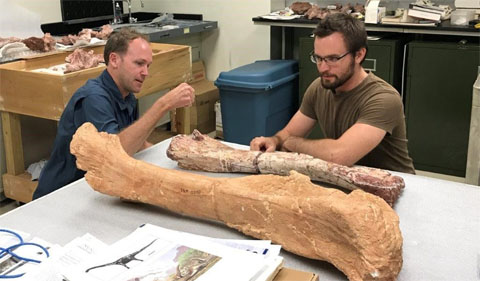Ohio University alumnus Dr. Eric Gorscak and Dr. Patrick O’Connor just published new exciting fossil discoveries from eastern Africa in PLOS ONE.
Gorscak is currently a research associate at the Field Museum of Natural History in Chicago and new assistant professor at the Midwestern University in Downers Grove, just outside of Chicago. H earned two degrees in Biological Sciences from the College of Arts & Sciences at OHIO, a B.S. in 2009 and a Ph.D. in 2016. O’Connor is Professor of Neuroscience & Anatomy at OHIO’s Heritage College of Osteopathic Medicine.

Dr. Pat O’Connor (left) and Dr. Eric Gorscak work in their lab at Ohio documenting fossil discoveries.
Much of the work published represents work Gorscak completed while a Biological Sciences graduate student at OHIO under the mentorship of O’Connor. Working together, they were able to identify and name a new species of dinosaur (Mnyamawamtuka moyowamkia [Mm-nya-ma-wah-mm-too-ka mm-oh-yo-wa-mm-key-ah] ).
The new dinosaur, the third now described from southwestern Tanzania by the NSF-funded team, is yet another member of the large, long-necked titanosaur sauropods. The partial skeleton was recovered from Cretaceous-age (about 100 million years ago) rocks exposed in a cliff surface in the western branch of the great East African Rift System.
Much of the dinosaur fossil record in Africa has yet to be discovered, and the OHIO team is leading the way in making such discoveries.
- Read more at “New dinosaur with heart-shaped tail provides evolutionary clues for African continent” in Compass.
Abstract for “A new African Titanosaurian Sauropod Dinosaur from the middle Cretaceous Galula Formation (Mtuka Member), Rukwa Rift Basin, Southwestern Tanzania” in Plos One: The African terrestrial fossil record has been limited in its contribution to our understanding of both regional and global Cretaceous paleobiogeography, an interval of significant geologic and macroevolutionary change. A common component in Cretaceous African faunas, titanosaurian sauropods diversified into one of the most specious groups of dinosaurs worldwide. Here we describe the new titanosaurian Mnyamawamtuka moyowamkia gen. et sp. nov. from the Mtuka Member of the Galula Formation in southwest Tanzania. The new specimen preserves teeth, elements from all regions of the postcranial axial skeleton, parts of both appendicular girdles, and portions of both limbs including a complete metatarsus. Unique traits of M. moyowamkia include the lack of an interpostzygapophyseal lamina in posterior dorsal vertebrae, pronounced posterolateral expansion of middle caudal centra, and an unusually small sternal plate. Phylogenetic analyses consistently place M. moyowamkia as either a close relative to lithostrotian titanosaurians (e.g., parsimony, uncalibrated Bayesian analyses) or as a lithostrotian and sister taxon to Malawisaurus dixeyi from the nearby Aptian? Dinosaur Beds of Malawi (e.g., tip-dating Bayesian analyses). M. moyowamkia shares a few features with M. dixeyi, including semi-spatulate teeth and a median lamina between the neural canal and interpostzygapophyseal lamina in anterior dorsal vertebrae. Both comparative morphology and phylogenetic analyses support Mnyamawamtuka as a distinct and distant relative to Rukwatitan bisepultus and Shingopana songwensis from the younger Namba Member of the Galula Formation with these results largely congruent with newly constrained ages for the Mtuka Member (Aptian–Cenomanian) and Namba Member (Campanian). Coupled with recent discoveries from the Dahkla Oasis, Egypt (e.g., Mansourasaurus shahinae) and other parts of continental Afro-Arabia, the Tanzania titanosaurians refine perspectives on the development of African terrestrial faunas throughout the Cretaceous—a critical step in understanding non-marine paleobiogeographic patterns of Africa that have remained elusive until the past few years.

















Comments